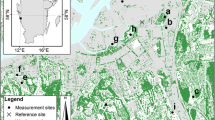Summary
In the extreme desert environment the potential energy load is high, consequently high temperatures might be a limiting factor for plant survival. Field measurements of plant temperatures in a Sonoran Desert ecosystem were made using fine thermocouples. Temperatures of six desert species were measured: Opuntia engelmannii, Opuntia bigelovii, Opuntia acanthocarpa, Echinocereus engelmannii, Larrea tridentata and Franseria deltoidea. Daily temperature profiles were used to compare the different responses of cacti and shrubs to the desert heat load and also to compare spring and summer responses. Leaf temperature of shrubs was at or near air temperature during both the mild, spring season and the hotter dry season. The cacti, on the other hand, absorbed and stored heat, thus temperatures were often above air temperature. The energy absorbed is determined largely by plant orientation and surface area exposed to the sun. Actual energy absorbed by the plants was estimated from energy diagrams.
The flat stem pads of Opuntia engelmannii plants are oriented to receive maximum sunlight without long periods of continuous heating. Opuntia bigelovii spines reflect and absorb much of the environmental energy load, thereby protecting the thick, succulent stems from overheating. The smaller stems of Opuntia acanthocarpa dissipate heat more effectively by their large surface area exposed to convective air currents. Leaves on desert shrubs remain nearer to air temperature than do succulent stems of cacti, because their very large surface to volume ratio allows them to dissipate much heat by convection.
Similar content being viewed by others
References
Alexandrov, V. Y.: Cytophysiological and cytoecological investigations of heat resistance of plant cells toward the action of high and low temperature. Quart. Rev. Biol. 39, 35–37 (1964).
Altman, P. L., Dittmer, D. S., eds: Environmental biology. Committee on Biological Handbooks. Federation of American Societies for Experimental Biology. Bethesda, Md. 694 p. (1966).
Ashby, E.: Transpiratory organs of Larrea tridentata and their ecological significance. Ecology 13, 182–188 (1932).
Billings, W. D., Morris, R. J.: Reflection of visible and infrared radiation from leaves of different ecological groups. Amer. J. Bot. 38, 327–331 (1951).
Budyko, M. I.: The heat balance of the earth's surface. (Transl. from Russian by Nina A. Stepanova. Leningrad.) National Bureau Standards, Washington, D. C. (1958).
Chew, R. M., Chew, A. E.: The primary productivity of a desert-shrub community. Ecol. Monogr. 35, 355–375 (1965).
Chow, P. N., Burnside, O. C., Lavy, T. L.: Physiological studies with prickly pear. Weeds 14(1), 58–62 (1966).
Curtis, O. F.: Leaf temperatures and the cooling of leaves by radiation. Plant Physiol. 11, 343–364 (1936).
Ehrler, W. L.: Daytime stomatal closure in Agave americana as related to enhanced water-use efficiency. Pages 239–247. In: Proc. Seminar on Physiol. Systems in Semiarid Environments, November 1967. Albuquerque, N. M.: Univ. of New Mexico Press 1968.
Gates, D. M.: Energy exchange in the biosphere. 151 p. New York: Harper & Row, Publ 1962.
—: The energy environment in which we live. Amer. Scientist 51, 327–348 (1963).
—: Leaf temperature and transpiration. Agron. J. 56, 273–277 (1964).
—: Energy, plants and ecology 46, 1–13 (1965).
—: Energy exchange and ecology. Bioscience 18, 90–95 (1968).
— Alderfer, R., Taylor, E.: Leaf temperatures of Desert Plants. Science 159, 994–995 (1968).
— Benedict, C. M.: Convection phenomena from plants in still air. Amer. J. Bot. 50, 563–573 (1963).
— Tibbals, E. C., Kreith, F.: Radiation and convection for ponderosa pine. Amer. J. Bot. 52, 66–71 (1965).
Idso, S. B., Baker, D. G.: Method for calculating the photosynthetic response of a crop to light intensity and leaf temperature by an energy flow analysis of the meterological parameters. Agron. J. 59, 13–21 (1967a).
—: Relative importance of reradiation, convection and transpiration in heat transfer from plants. Plant Physiol. 42, 631–640 (1967b).
Kearney, T. H., Peebles, R. H.: Arizona flora, 2nd ed. Berkeley: University of Calif. Press 1960.
Pallas, J. E., Jr., Bertrand, A. R., Harris, D. G., Elkins, C. B., Jr., Parks, C. L.: Research in plant transpiration: 1962. Agricultural Research Service, Production Research Report No. 87. Washington, D. C. 56 p. (1965).
Patten, D. T., Dinger, B. E.: Carbon dioxide exchange patterns of cacti from different environments. Ecology 50, 686–688 (1969).
Simmons, L. F. G.: A shielded hot-wire anemometer for low speeds. J. Sci. Instr. 26, 407–411 (1949).
Thut, H. F.: Relative humidity variations affecting transpiration. Amer. J. Bot. 25, 589–595 (1938).
Waggoner, P. E., Shaw, R. H.: Temperature of potato and tomato leaves. Plant Physiol. 27, 710–724 (1952).
Watson, A. N.: Preliminary study of the relation between thermal emissivity and plant temperature. Ohio J. Sci. 33, 435–450 (1933).
Author information
Authors and Affiliations
Rights and permissions
About this article
Cite this article
Gibbs, J.G., Patten, D.T. Plant temperatures and heat flux in a Sonoran Desert ecosystem. Oecologia 5, 165–184 (1970). https://doi.org/10.1007/BF00344882
Received:
Issue Date:
DOI: https://doi.org/10.1007/BF00344882




